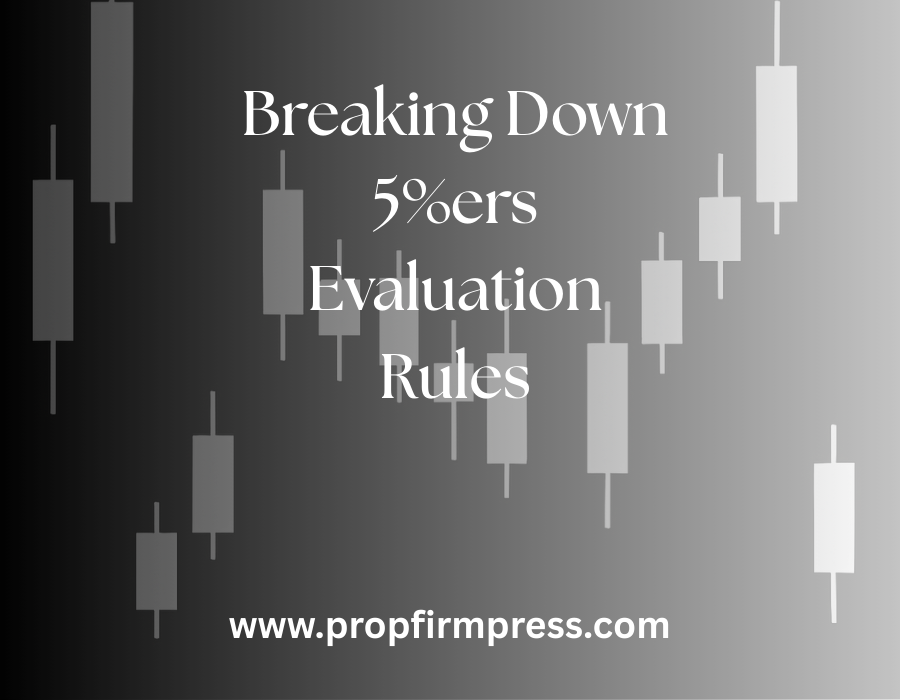Breaking Down 5%ers Evaluation Rules
The 5%ers trading program has gained significant attention in the prop trading community due to its unique evaluation process and funding model. Aspiring traders worldwide seek to join their ranks, but understanding the evaluation rules is crucial for success. This article breaks down the key components of the 5%ers evaluation rules, helping traders navigate the challenge efficiently and increase their probability of funding.
Understanding the 5%ers Challenge Structure
The 5%ers offer a two-step evaluation process designed to select disciplined traders who can manage real capital responsibly. The first step, often referred to as the “Evaluation Challenge,” requires traders to achieve specific profit targets while adhering to maximum drawdown limits. After passing this stage, traders enter the “Verification” round to confirm their trading abilities under live conditions. Completion of the verification grants access to funding from 5%ers, where traders can trade company capital with profit splits.
Both stages have clearly defined rules related to profit targets, drawdown restrictions, trading instruments, and position sizing. Understanding each of these elements is vital to avoid disqualification and maintain steady progress throughout the evaluation.
Profit Target Requirements
The primary objective of the 5%ers evaluation is to reach a profit target, which is 5% of the initial capital in the account. For example, if the challenge account starts with $24,000, the trader needs to earn $1,200 to pass the evaluation. This goal encourages consistent profitability and risk management over aggressive or opportunistic trading.
Traders have a maximum of 30 calendar days to hit this profit target, which adds a time constraint that tests not only trading skill but also patience and discipline. While the target is fixed percentage-wise, the dollar amount varies according to the account size the trader selects at the beginning of the challenge.
Drawdown Limits and Risk Management
Regulating risk is an essential part of the 5%ers evaluation rules. The program imposes a maximum allowable drawdown, which traders must not exceed at any point during the challenge. This drawdown consists of two critical components:
- Maximum Daily Drawdown: This typically caps losses for any single day to prevent rapid depletion of the account balance.
- Maximum Overall Drawdown: This is the cumulative maximum loss allowed from the initial account balance.
For standard accounts, the maximum overall drawdown usually sits at 5%, mirroring the profit target. The daily drawdown limits vary depending on the account size but often hover around 2 to 3 percent. Breaching these thresholds results in immediate challenge failure, emphasizing the importance of thoughtful risk management and conservative position sizing.
Trading Instruments Allowed
The 5%ers program provides traders with the flexibility to trade multiple asset classes while staying within the evaluation framework. Approved trading instruments typically include forex currency pairs, indices, commodities, and some cryptocurrencies. However, the allowable instruments depend on the specific program rules at the time of enrollment, so traders must confirm which instruments they can trade before beginning.
Trading too many instruments or deviating into non-approved assets could lead to contest failure. Additionally, the program encourages traders to focus on instruments where they hold strong expertise to maximize their chances of meeting profit and drawdown criteria efficiently.
Position Sizing and Minimum Trading Days
In addition to profit and risk targets, the 5%ers enforce rules around minimum trading days and position sizing to ensure consistency in trading style and exposure management.
Traders must execute trades on a minimum number of days, often around 5 out of the 30 days in the challenge. This rule discourages holding a single position for an extended period without active trading and demonstrates consistent engagement and discipline.
Regarding position sizing, there are preset minimum lot sizes to prevent excessively small trading volumes that would not sufficiently test a trader’s abilities at scale. Traders must adhere to these minimums unless granted special permission or exceptions by the prop firm.
Important Restrictions and Prohibited Activities
The 5%ers evaluation rules also outline certain prohibitions designed to maintain a level playing field and reduce manipulation risks. For instance, arbitrage strategies and high-risk leveraged play are typically banned or discouraged. Traders cannot use hedging techniques, meaning offsetting opposite positions simultaneously, which can obscure actual performance metrics.
Additionally, news trading or fast scalping during major releases might be restricted, depending on program terms. This helps the prop firm monitor risk exposure and ensure traders use sustainable trading methods aligned with long-term profitability.
Tips for Successfully Passing the 5%ers Evaluation
Successfully passing the 5%ers evaluation requires more than just technical knowledge of the rules. Traders should adopt a strategic approach that combines conservative risk management, consistent entry and exit strategies, and emotional discipline.
Keep position sizes moderate to stay within drawdown limits while aiming for steady gains rather than quick windfalls. Trade instruments you thoroughly understand, and avoid overtrading. Stick to trading on your best days to comply with minimum trading day rules without overexposing yourself.
Use a trading journal or PnL tracker to monitor your progress and psychological states. This ongoing review helps identify weaknesses and adjust strategies accordingly to stay on track within the 30-day timeframe.
Verifying Your Results and Moving to Live Funding
Upon completing the evaluation and verification stages, traders who meet the profit and risk criteria receive funded accounts. At this point, they can trade using 5%ers capital, typically with profit splits ranging from 50% to 80%, depending on account size and trading level.
Verification involves replicating consistent trading results in a live environment to confirm authenticity of trading skills. It mitigates risks for the prop firm by validating the trader’s ability to perform under real conditions without taking excessive risk.
Understanding these post-evaluation steps enables traders to prepare mentally and strategically for the transition into live funded trading, which presents further challenges and opportunities.
Trading success comes from discipline and review. Unlock your edge with the Trader’s Monthly PnL Tracker.
